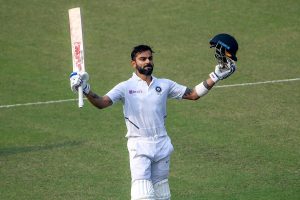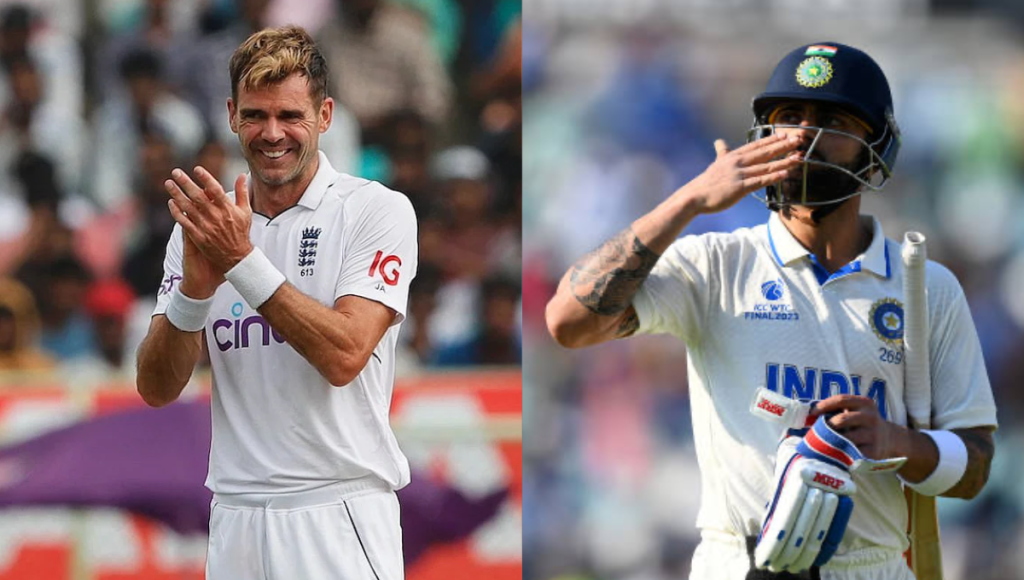Cricketing world often debates the greatest players across formats, James Anderson, one of England’s finest bowlers, has offered a unique perspective on Kohli’s prowess, particularly as a finisher. Anderson’s insights, drawn from years of battling Virat Kohli on the field, paint a picture of a batsman whose finishing skills are not just about the runs but the psychological edge he brings to the game.
Journey of Virat Kohli as a finisher didn’t start with accolades but with challenges, especially against bowlers like Anderson. The early days saw Kohli struggling, making him look like a “walking wicket” as Anderson once humorously remarked. However, what sets Kohli apart, and what Anderson acknowledges, is his evolution. From those initial struggles to becoming a master of the chase, Kohli’s transformation is a testament to his relentless drive for improvement.

The 2014 series in England was a turning point. Virat Kohli, after being dismissed multiple times by James Anderson, returned in 2018 with a new strategy. Virat Kohli decided to attack, playing Anderson’s deliveries before they swung, effectively turning the tables. This tactical shift not only showcased Kohli’s adaptability but also his mental fortitude, qualities essential for a finisher. Anderson, reflecting on this period, noted how Kohli’s approach had evolved, making him one of the toughest batsmen to dismiss, especially in crucial moments.
“It is no surprise that when he gets in that situation, with his mentality, it is just like it is meant to be. His self-belief is so high,” added Anderson.
“Kohli batting at number 3 gets those hundreds while Bevan was renowned for getting his 50s, 60s and being at the end, while Kohli gets the big score, to get his teams over the line. I honestly can’t think of a better finisher and greater white-ball players than him [Kohli],” James Anderson added.
Kohli’s finishing isn’t just about the last overs in ODIs or T20s; it’s about his ability to anchor innings, accelerate when needed, and finish games from any situation. His records speak volumes: the fastest to 8,000, 9,000, 10,000, and 11,000 runs in ODIs, often coming in situations where the game was on the line. His chase against Australia in 2013, where he scored a century off just 52 balls, exemplifies his finishing ability, making Anderson and many others reconsider what it means to be a finisher.
Moreover, Kohli’s psychological impact on the game cannot be understated. His battles with Anderson were not just about cricket but about proving a point. Each dismissal or century was a chapter in a larger narrative of rivalry and respect. Anderson’s admission of feeling like he could get Kohli out every ball in the early days to feeling like he couldn’t get him out at all later, highlights Kohli’s growth not just as a batsman but as a finisher who could alter the dynamics of a match with his presence.
The essence of Kohli’s finishing lies in his ability to read the game, adapt, and dominate. Whether it’s through aggressive stroke play or patient accumulation, Kohli’s innings often culminate in victories, making him not just a scorer of runs but a maker of matches. Anderson’s perspective, coming from someone who has both dismissed and been dominated by Kohli, adds a layer of credibility to the claim of Kohli being the greatest finisher.
Statistics and records provide one view, Anderson’s firsthand experience against Kohli offers a deeper insight into what makes Kohli exceptional. His ability to finish games, often under immense pressure, combined with his psychological warfare, places him in a league of his own. Kohli’s legacy as a finisher, as per Anderson, isn’t just about the runs but about how he changes the game’s narrative, making him, arguably, the greatest finisher cricket has ever seen.

